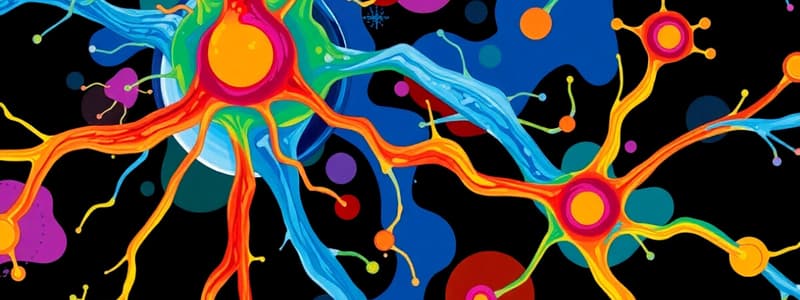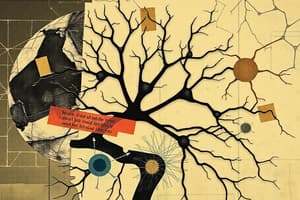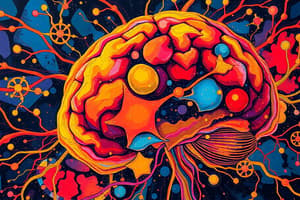Podcast
Questions and Answers
Which part of the spinal cord contains neurone cell bodies?
Which part of the spinal cord contains neurone cell bodies?
- Spinal canal
- White matter
- Peripheral matter
- Grey matter (correct)
Which nervous system division is responsible for voluntary movement?
Which nervous system division is responsible for voluntary movement?
- Somatic nervous system (correct)
- Peripheral nervous system
- Autonomic nervous system
- Sensory nervous system
What is an involuntary response following a sensory stimulus called?
What is an involuntary response following a sensory stimulus called?
- Neurotransmission
- Voluntary action
- Reflex (correct)
- Motor function
What is the simplest form of a reflex arc typically composed of?
What is the simplest form of a reflex arc typically composed of?
How is a spinal reflex different from other reflexes?
How is a spinal reflex different from other reflexes?
What type of potential is established when the threshold value of the temperature receptor is exceeded?
What type of potential is established when the threshold value of the temperature receptor is exceeded?
Which neuron directly carries an action potential to the biceps muscle?
Which neuron directly carries an action potential to the biceps muscle?
Why are reflex actions considered to have an adaptive value?
Why are reflex actions considered to have an adaptive value?
What is the primary reason reflexes are fast?
What is the primary reason reflexes are fast?
Which ions are primarily involved in establishing the resting potential across the axon membrane?
Which ions are primarily involved in establishing the resting potential across the axon membrane?
What does the phospholipid bilayer of the axon membrane do?
What does the phospholipid bilayer of the axon membrane do?
In which of the following scenarios would the brain override a reflex action?
In which of the following scenarios would the brain override a reflex action?
What primarily contributes to the overall negative state inside the axon?
What primarily contributes to the overall negative state inside the axon?
What happens to the membrane potential during depolarization?
What happens to the membrane potential during depolarization?
Which type of channels are primarily responsible for initiating the action potential?
Which type of channels are primarily responsible for initiating the action potential?
What is the threshold potential necessary to trigger an action potential?
What is the threshold potential necessary to trigger an action potential?
What role does positive feedback play in the action potential process?
What role does positive feedback play in the action potential process?
What occurs after the action potential reaches approximately +40 mV?
What occurs after the action potential reaches approximately +40 mV?
How are potassium ions affected during the resting potential?
How are potassium ions affected during the resting potential?
What defines the equilibrium state in the axon?
What defines the equilibrium state in the axon?
What is the function of the sodium-potassium pump in an axon?
What is the function of the sodium-potassium pump in an axon?
Why is the inside of an axon negatively charged compared to the outside?
Why is the inside of an axon negatively charged compared to the outside?
What role do leak channels play in the resting potential of an axon?
What role do leak channels play in the resting potential of an axon?
How does the permeability of the axon membrane to potassium ions compare to sodium ions?
How does the permeability of the axon membrane to potassium ions compare to sodium ions?
What creates a chemical gradient for sodium and potassium ions in an axon?
What creates a chemical gradient for sodium and potassium ions in an axon?
What is referred to as the resting potential of an axon?
What is referred to as the resting potential of an axon?
What occurs primarily due to the activity of the sodium-potassium pump?
What occurs primarily due to the activity of the sodium-potassium pump?
What triggers the movement of sodium and potassium ions in and out of the axon?
What triggers the movement of sodium and potassium ions in and out of the axon?
What is the primary role of receptors in an organism?
What is the primary role of receptors in an organism?
Which structure is responsible for transmitting nerve impulses away from the cell body?
Which structure is responsible for transmitting nerve impulses away from the cell body?
What type of neurones transmit impulses faster due to the presence of a myelin sheath?
What type of neurones transmit impulses faster due to the presence of a myelin sheath?
What is the function of Schwann cells in the nervous system?
What is the function of Schwann cells in the nervous system?
What is the central control center that links receptors and effectors in more complex organisms?
What is the central control center that links receptors and effectors in more complex organisms?
What are the gaps between adjacent Schwann cells called?
What are the gaps between adjacent Schwann cells called?
Which portion of the neuron is responsible for carrying nerve impulses towards the cell body?
Which portion of the neuron is responsible for carrying nerve impulses towards the cell body?
Flashcards
Nervous system
Nervous system
A communication system that coordinates rapid responses using nerve impulses.
Endocrine system
Endocrine system
A communication system that uses hormones to coordinate responses over longer periods.
Stimulus
Stimulus
Any change in the environment that causes a reaction from an organism.
Response
Response
Signup and view all the flashcards
Sensory neurone
Sensory neurone
Signup and view all the flashcards
Motor neurone
Motor neurone
Signup and view all the flashcards
Hormones
Hormones
Signup and view all the flashcards
Nerve impulses
Nerve impulses
Signup and view all the flashcards
Spinal Cord
Spinal Cord
Signup and view all the flashcards
Grey Matter
Grey Matter
Signup and view all the flashcards
White Matter
White Matter
Signup and view all the flashcards
Central Nervous System (CNS)
Central Nervous System (CNS)
Signup and view all the flashcards
Peripheral Nervous System (PNS)
Peripheral Nervous System (PNS)
Signup and view all the flashcards
Reflex Arc
Reflex Arc
Signup and view all the flashcards
Spinal Reflex
Spinal Reflex
Signup and view all the flashcards
Generator potential
Generator potential
Signup and view all the flashcards
Action potential
Action potential
Signup and view all the flashcards
Relay neurone
Relay neurone
Signup and view all the flashcards
Effector
Effector
Signup and view all the flashcards
Involuntary reflexes
Involuntary reflexes
Signup and view all the flashcards
Adaptive value
Adaptive value
Signup and view all the flashcards
Resting potential
Resting potential
Signup and view all the flashcards
Phospholipid bilayer
Phospholipid bilayer
Signup and view all the flashcards
Potassium Ion Movement
Potassium Ion Movement
Signup and view all the flashcards
Negatively Charged Proteins
Negatively Charged Proteins
Signup and view all the flashcards
Equilibrium in Ion Movement
Equilibrium in Ion Movement
Signup and view all the flashcards
Depolarisation
Depolarisation
Signup and view all the flashcards
Voltage-Gated Channels
Voltage-Gated Channels
Signup and view all the flashcards
Threshold Potential
Threshold Potential
Signup and view all the flashcards
Positive Feedback in Action Potential
Positive Feedback in Action Potential
Signup and view all the flashcards
Receptors
Receptors
Signup and view all the flashcards
Central nervous system
Central nervous system
Signup and view all the flashcards
Neurones
Neurones
Signup and view all the flashcards
Myelin sheath
Myelin sheath
Signup and view all the flashcards
Nodes of Ranvier
Nodes of Ranvier
Signup and view all the flashcards
Leak channels
Leak channels
Signup and view all the flashcards
Sodium-potassium pump
Sodium-potassium pump
Signup and view all the flashcards
Polarised axon
Polarised axon
Signup and view all the flashcards
Chemical gradient
Chemical gradient
Signup and view all the flashcards
Electrical gradient
Electrical gradient
Signup and view all the flashcards
Potassium ion permeability
Potassium ion permeability
Signup and view all the flashcards
Study Notes
Nervous Communication and Neurones
- The nervous system coordinates homeostatic mechanisms and responses to internal and external environmental changes.
- The nervous system and endocrine system both coordinate responses, but the nervous system is faster.
- The nervous system uses nerve impulses, while the endocrine system uses hormones.
- The nervous system consists of the brain and spinal cord (central nervous system).
Neurone Structure
- Neurones (nerve cells) rapidly transmit electrochemical changes (nerve impulses).
- A neurone consists of a cell body, dendrites, and an axon.
- The cell body contains the nucleus and other organelles like mitochondria and rough endoplasmic reticulum.
- Dendrites are small extensions of the cell body, receiving signals.
- The axon carries impulses away from the cell body, potentially covered with a myelin sheath.
- Neurons may be sensory (afferent), relay, or motor (efferent) depending on their function.
Sensory Receptors
- Sensory receptors detect internal and external stimuli.
- Chemoreceptors detect chemicals in taste buds.
- Taste buds contain chemoreceptors that detect salt, sour, bitter, and sweet tastes.
- Chemoreceptor cells convert stimulus energy into receptor potentials.
- Receptor potentials create generator potentials, that in turn initiate action potentials.
The Reflex Arc
- A reflex arc describes an automatic response to a stimulus.
- The spinal cord is involved in spinal reflexes.
- The reflex arc includes a stimulus, a receptor, two or more neurones, and an effector.
- A sensory neurone carries impulses to the spinal cord from a receptor.
- A relay neurone connects the sensory to a motor neurone.
- A motor neurone carries impulses from the spinal cord to an effector (like a muscle).
- The sensory and motor neurones are connected through a synapse with another neurone.
The Nerve Impulse
- A nerve impulse is a self-propagating wave of electrical disturbance.
- Nerve impulses involve a change in the electrical potential difference across the axon membrane between a resting potential and an action potential.
- The resting potential is the state of a neuron when it is not transmitting an impulse and is maintained via ion pumps and channels.
- An action potential is a temporary reversal of the electrical potential difference across the axon membrane, caused by the rapid movement of sodium and potassium ions.
Transmission of Impulses Along a Neuron
- Transmission of signals may be along an unmyelinated or myelinated neurone.
- In unmyelinated neurones, local currents transmit the signal.
- In myelinated neurones, the signal jumps between gaps in the myelin sheath called nodes of Ranvier (saltatory conduction).
Speed of Nerve Impulse Transmission
- Factors affecting impulse speed include the myelin sheath, axon diameter, temperature, and the refractory period.
- Myelin increases impulse speed through saltatory conduction.
- A larger axon diameter reduces resistance.
- Higher temperature increases ion diffusion.
- Refractory period limits impulse frequency.
Studying That Suits You
Use AI to generate personalized quizzes and flashcards to suit your learning preferences.





